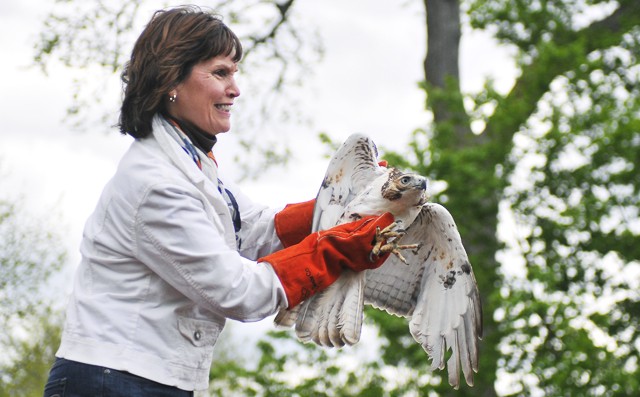For more than 20 years, Pat Redig has watched in wonderment as thousands of rehabilitated raptors have been released back into the wild at the Spring Raptor Release. âÄúIt never, ever gets old,âÄù said Redig, founder of the Raptor Center at the University of Minnesota College of Veterinary Medicine. âÄúIt started as a little kernel, and IâÄôm always touched to see people show so much interest.âÄù The Raptor Center released four birds in front of about 3,000 people Saturday at the Hyland Lake Park Reserve Visitor Center in Bloomington, Minn. The majority of birds the center treats have been injured through some kind of interaction with humans, including being hit by a car, flying into windows, being shot and getting electrocuted by power lines. Executive director of the Raptor Center and assistant clinical professor Julia Ponder said the raptors must have no medical problems and must be able to fly well before they are released. âÄúThey have to be back at 100 percent,âÄù she said. Members of the Raptor Center, corporate sponsor Delta Airlines and U.S. Rep. Betty McCollum, D-Minn., helped release a CooperâÄôs hawk, an American kestrel and two Red-tailed hawks. McCollum released a Red-tailed hawk and has a record of championing environmental preservation and protection. âÄúThis is a fantastic opportunity for Minnesotans to get involved and learn more about these beautiful birds,âÄù McCollum said. For each bird, the crowd counted down from three and then the bird was thrust up in the air and flew away quickly. The crowd was mostly made up of families who had the opportunity to learn from members of Three Rivers Park District and the Raptor Center. More than five booths allowed visitors to touch feathers, play games and purchase merchandise. Founded in 1974, the Raptor Center treats about 800 birds a year and trains students from all over the world in avian medicine and surgery. The center is at the forefront of emerging raptor health and populations issues, and more than 250,000 participate in public education programs and events each year. Complications donâÄôt stop after the birds are rehabilitated. Spring has the potential for territorial battles between birds, so the center did nest surveys before the event to make sure there were no nesting birds of the same species in the area of the release. âÄúIt was some of the centerâÄôs internsâÄô graduation day today,âÄù Redig said, âÄúItâÄôs an extra-emotional day, but itâÄôs a day full of accomplishment.âÄù

Image by Joe Michaud-Scorza
Congresswoman Betty Mccollum releases a red tail hawk back into the wild at the Raptor Center’s Spring Raptor Release in Bloomington on Saturday.
Raptors released back into the wild
The College of Veterinary Medicine treats about 800 birds each year.
by Adam Daniels
Published May 2, 2010
0
More to Discover







